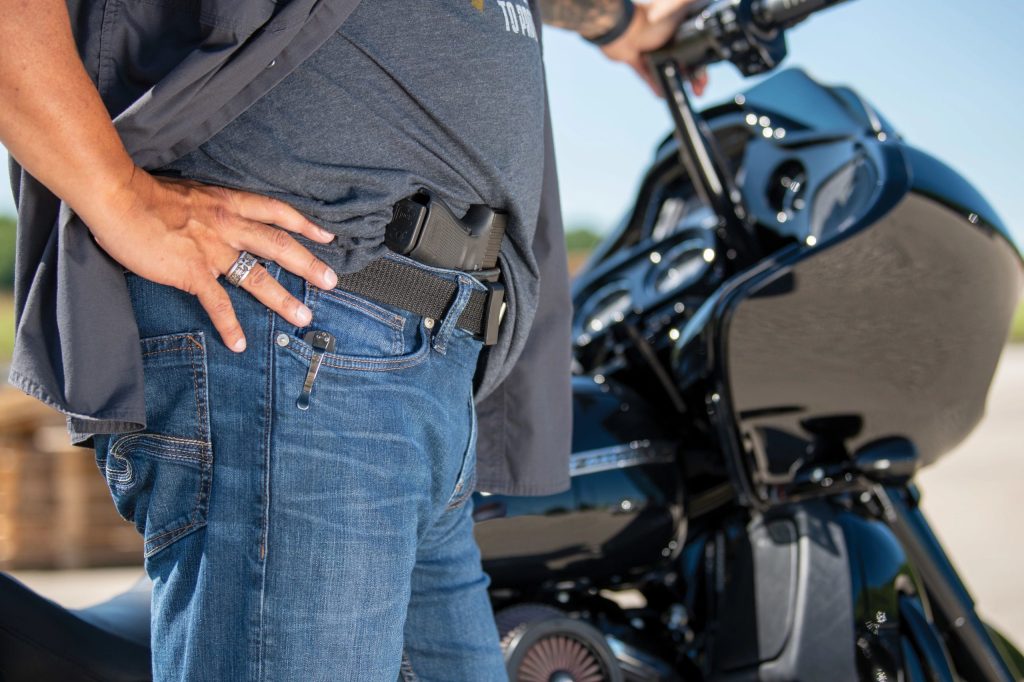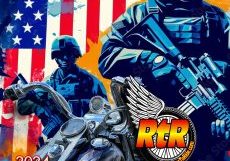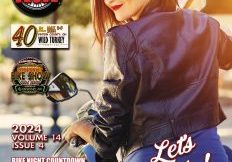Carrying on a Motorcycle

Gun Laws and Vehicles
Concealed carry in vehicles varies widely from state to state. In many states, you are expected to keep your handgun unloaded and cased in the trunk of your vehicle or in a locked storage area which is inaccessible to both the driver and the passengers. Those with a concealed carry permit may be permitted to carry a concealed carry weapon. Again, this depends on the state.
Your concealed carry permit may be accepted in other states if the other states accept the Concealed Carry Reciprocity legislation. Most—but not all—states do.
When you are concealed carrying on a motorcycle, the rules are not a lot different from those for carrying in any type of vehicle. So, there aren’t a lot of major modifications to your existing concealed carry permit.
Factors to Remember When You’re Riding a Motorcycle
While riding on or in any vehicle while you are concealed carrying is pretty much the same, there are some additional challenged you have to be aware of if you are going to ride a motorcycle and carry a concealed weapon.
1. Remember It’s a Concealed Carry Weapon
Depending on where you carry, your biggest challenge may be to keep that firearm out of sight.
The best positions for concealed carry when riding a motorcycle depend on personal preference and your motorcycle riding style. For example:
Some motorcycles require you to have a strong forward leaning position. In cases like that inside the waistband concealed carry could be very tricky. Instead, you might consider a pocket holster. The pocket holster will have to fit inside your jacket or it won’t be secure.
If pocket holsters aren’t your thing or you don’t feel your firearm will be secure, you might want to consider a behind the back holster at five or six o’clock position. The downside is that this position may not be secure at high speeds and in sharp turns.
Some bikes require an upright seating position. This gives you more concealed carry holster positions. Inside the waistband is popular. You can carry securely at either three o’clock, or a kidney position. I wouldn’t recommend an appendix position because of where your legs are positioned.
If you decide to carry inside the waistband, make sure you have your passenger straddle but be aware of your firearm’s location.
If you drive your motorcycle in a reclined or backward leaning position, an appendix holster is reasonable if your gun isn’t too big. You might also give thought to a pocket holster or an inside the waistband holster.
The type of motorcycle you ride, your style of riding and the type of gun you’ve chosen as your every-day concealed carry all affect your decision about what type of holster and carry position works best for you.
Retention of your firearm is always a major consideration. Be sure to secure the trigger guard inside your holster. Keep your gun on you unless it is locked in the cargo box.
Avoid holsters that expose your weapon and let it fall out. Ankle holsters, purse holsters, and thigh holsters are bad choices when riding a motorcycle. The best idea is to try various holsters and carrying positions to find the one that works best for you.
Cover garments are also a concern. You have to contend with riding position, moving on and off your bike, making tight turns, and things like the wind. The farther up your torso you carry, the easier it will be to conceal your weapon.
Another consideration is quick access. Sure! It’s great to have your weapon safely secured in its holster. It’s good to have it well covered by garments. But, you also need to be able to get your weapon drawn quickly and smoothly.
2. Find The Best Concealed Carry Styles
Research into five ways to concealed carry styles looked at three criteria:
- – Concealability: degree of invisibility of your concealed carry
- – Draw Speed: How fast and easy can you reach and draw your weapon?
- – Ride Comfort: How suitable is this style for use while riding a motorcycle?
Some concealed carry styles were omitted because they were unsuitable for motorcycle concealed carrying. Ones that were eliminated included ankle carry and off-body carry. Others were eliminated because they failed to conceal or did not allow quick draw and/or they were not comfortable for motorcyclists.
What did they discover? Pocket carry is convenient and doesn’t require extra gear. Moreover pocket carry is easily accessible from a seated position astride a bike. On the downside, pocket carry is very bulky and does not conceal well.
The study also looked at belt carry both inside and outside the waistband. This style was rated the most convenient as well as best access. Where the gun is carried was crucial as your weapon could be uncomfortable or hard to get at or positioned with the muzzle in a dangerous spot.
A major concern with this carry is potential for your weapon to be lost because of vibrations, bumpy roads, or holsters poorly snapped to your gun belt.
3. Consider What Your Hands are Doing
In most cases, you need your right hand on the throttle. If you are right handed you can’t shoot and drive. Drawing, firing and operating your motorcycle at the same time happens only in the movies.
4. Look Into Biker-Friendly Holsters
Your choice of holsters has a lot to do with your personal carry preferences. However, in a vehicle or on a motorcycle you also have to consider what is feasible and comfortable. For example, appendix carry while driving a car is uncomfortable. It can also not be the way to go on a bike.
Depending on your build, your personal carry preference, and the gun you like to carry and how your bike rides, you may have to make some concessions. Your favorite gun and/or holster may just not work.
A shoulder or chest rig works very well for motorcycling. However, consideration has to be given to substantial cover garment.
The weather is also a factor. In the hotter months and/or in a tropical climate heavy black leather or Kevlar-reinforced clothing can be downright uncomfortable.
During the summer, you might change to belly bands holsters and holster that fit under a shirt.
5. Maintaining Your Weapon
When you’re riding a motorcycle, your weapon is subjected to wind, rain, snow, ice, extremes of heat and cold, salt air, dust, and body oils and sweat. Even if you never shoot or draw your handgun, you need to step up your gun-cleaning regimen.
6. Be Leery of Off-Body Carry
If you decide to off-body carry in a purse, a messenger bag, a backpack, or a briefcase, this introduces more potential problems. You can’t exactly strap it on or throw it over your shoulder. Even a backpack puts you off balance and causes wind resistance.
Some motorcycle jackets have “outlaw pockets”. These are deep and close with snaps. You will usually find them on the inside of the jacket to the left of the chest. These can easily accommodate a compact or subcompact concealed carry pistol. However, here’s the problem. What happens when you want to take your jacket off?
7. Maintaining Control of Your Weapon
One of the biggest worries of any concealed carry weapon owner is maintaining control over his/her handgun at all times. This is a lot harder than it sounds when you’re riding a motorcycle. Your jacket has to cover your weapon in the face of wind, rain, and a speeding machine. If you’re getting on and off your bike you have to be careful not to let your weapon show. When you enter a bank, a post office, a school, or a courthouse where can you stash that gun so it is safe from thieves? Do you leave it in your saddlebags or other storage space?
8. Bike Saddlebags
Police usually lock their duty belt, gun and other equipment in the trunk of their squad car when they leave their vehicle for a restaurant or to use the restroom. Motorcycle cops don’t have this luxury. Where can they stash equipment?
It’s tempting to leave it concealed on your person. However, as tempting as this is, remember that bike saddlebags are certainly not as secure as a car trunk. Thieves are less likely to break into a car than they are to break into your saddlebag. The trick is to be subtle about stowing a firearm. Just as it is concealed while you are carrying, it should be as concealed as you place it somewhere secure on your bike.
Here’s a good suggestion from an experienced biker. When you go into a place of business like a bank or a private home which is a no-gun area, stop in a safe place within a half a mile or so of your destination and lock your weapon in a safe place like a tour pack. Not saddle bag.
Final Thoughts
- Plan how you will deal with your weapon in various scenarios. That planning as well as trial-and-error will go a long way toward making your life less stressful.
- Those who ride a lot caution against holsters that fail to secure your weapon securely. They tell of times when they went into a skid and their handgun fell out of their pants and onto the road.
- They also suggest you get a secure storage compartment on your bike to place your handgun, passport, wallet and other valuables.
- Improper carrying can lead to loss of your pistol. Guns are expensive and you do not want them to fall into the wrong hands.
- It is not unheard of for motorcyclists to go tumbling through the air. Safeguarding your weapon against such a possibility is a wise plan. A good retention holster or one with a thumb break and a lanyard chord could save your gun from damage or loss. In case of a roll or a skid, your bike will slide and your saddlebag will also suffer. Having a tour pack will protect your valuable items where saddlebags will not.
- If you use an inside the waistband holster and cross draw with your left hand you can still shift and clutch and keep your throttle hand free.
- If you go into a skid and your weapon is in an outside the waistband holster, chances are your weapon won’t be there when you get out of the skid.
- Think seriously about position. In a one or eleven o’clock position, a slide down the road will do damage to your weapon.
- The standard or upright position on a standard bike is statistically the safest riding position. It is also the most comfortable for most body types.
Please note that this article is posted for general information and discussion purposes only and is NOT meant to serve as legal advice. Please seek out the laws of your state and / or an attorney for legal advice about your own personal weapon and how to handle / use it. We strongly recommend formal and constant training for anyone carrying or using a firearm.
Read More of Our Magazines
Looking for more riding inspiration, tips, and event highlights? Explore our complete collection of past Reasons to Ride magazines in our Past Issue Bookshelf. Each issue is packed with valuable content for riders, including scenic routes, gear reviews, and updates from the motorcycle community.










